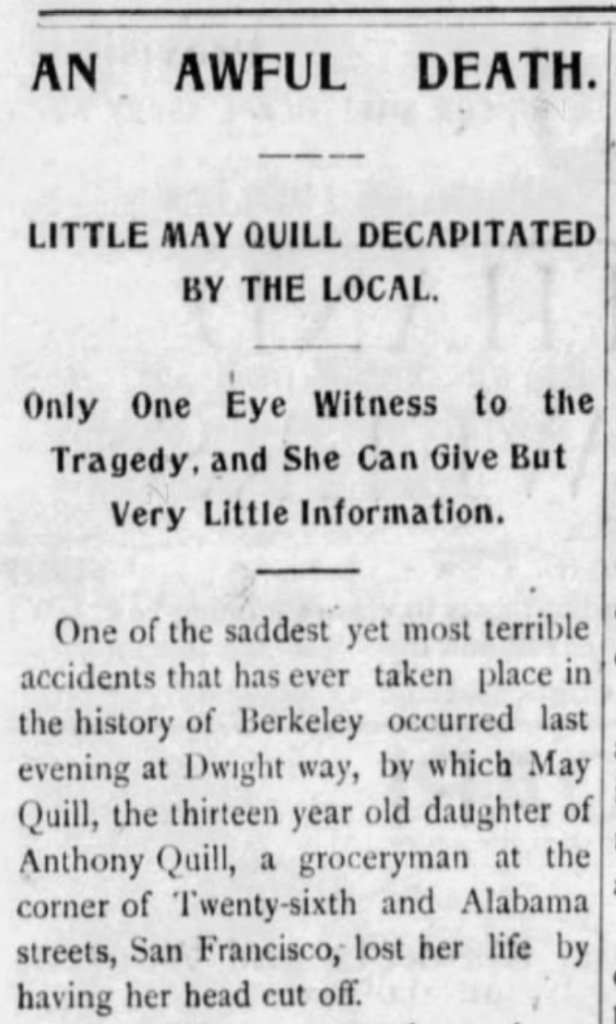
Doing impromptu research on railroad mayhem of yore — unwary yard workers and pedestrian getting their feet caught in frogs and then run over by trains and the like — I found myself looking through old, old numbers of the long dead but still remembered Berkeley Gazette.
For a town that had maybe 10,000 people in the mid-1890s, Berkeley seems to have more than its share of dreadful rail episodes. The Gazette did not hold back on details, though it sometimes illustrated an odd sense of priority (no, not propriety) in how it ordered its facts.
An example from the front page of February 17, 1896.
An Awful Death.
Little May Quill Decapitated by the Local.
Only One Eye Witness to the Tragedy, and She Can Give But Very Little Information.
One of the saddest yet most terrible accidents that has ever taken place in the history of Berkeley occurred last evening at Dwight way, by which May Quill, the thirteen year old daughter of Anthony Quill, a grocery man at the corner of Twenty-sixth and Alabama streets, San Francisco, lost her life by having her head cut off.
I know the style of the day was to provide layers of detail in the descending series of headlines and subheads above the story, but I can’t help but admire the writers and editors who managed to work in the employment details of the victim’s father in the lede without touching on how the victim suffered her gruesome injuries.
Here’s how the San Francisco Call of the same date, on page 11 under the heading “Interesting Report of Up-to-Date News Items From Alameda County”:
Awful Death at Berkeley.
Young Girl Crushed Under the Wheels of a Local Train.
Was Killed Instantly.
The Wheels Passed Over Her Neck and Severed the Head from the Body.
There Was But One Witness.
Little May Quill the Victim—The Train Went on to the Next Station—Who Is to Blame?
Berkeley, Cal., Feb. 16.—May Quill, a girl of 13 years, who lives with Mrs. Michael J. Powell at the corner of Magee [sic] and Allston way, Berkeley, was instantly killed by the 7 o’clock south bound local train this evening while attempting to alight from it near Dwight way station. The wheels passed over her head, completely severing it from her body and crushing it beyond description. No other injuries to her body were sustained save a few bruises. Her clothing was not even tattered.
(Brutally explicit descriptions of streetcar victims seems to have been a specialty for the Call. Here’s how it described a 1906 incident in which a teenage girl was struck by a car at Mission and Third streets in San Francisco: “Mowed down by the thirty-ton juggernaut, her body was churned round the forward wheels and mangled so frightfully that it became almost welded to the [car] and could not be removed for more than an hour. When it was finally recovered the appearance it presented unnerved the great gathering that had watched employees of the United Railroads working round the car with primitive wrecking apparatus, and heads were turned away as it was borne to the Morgue wagon.”)
I see regular reports about rail deaths in the Bay Area today — mostly involving BART and Caltrain. The prevailing presumption is that most of these cases involve people taking their own lives. BART generally describes these incidents only as “major medical emergencies.” Perhaps the next day, BART police will refer to the incident by saying that they responded to “a report of a person under a train” and adding that the local coroner was called to the scene.
I often feel like those reports are overly sanitized and we ought to know more about the circumstances. How much more? Well, enough to have some insight into whatever the authorities know about the circumstances. The further gruesome details so frequently printed at the turn of the 20th century — no, I don’t need those. But those old accounts do make me wonder about the public appetite for that kind of reporting back then and about how sensitivities appear to have changed so much, at least in some respects, today.
